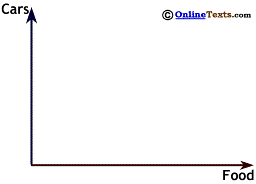

Copyright © 1995-2004 OnLineTexts.com, Inc. - All Rights Reserved
 Let's look at a simple example of trade between two countries. Country A can produce 100 units of Food a day, or 50 Cars per day, or it can produce some of each. For Country A the opportunity cost of a Car is 2 units of Food.
Let's look at a simple example of trade between two countries. Country A can produce 100 units of Food a day, or 50 Cars per day, or it can produce some of each. For Country A the opportunity cost of a Car is 2 units of Food.
Country B can produce 100 Cars per day or 50 Food units. For Country B the opportunity cost of a Car is 1/2 a unit of Food.
Country A has a comparative advantage (and an absolute advantage) in Food production while Country B's comparative advantage (and absolute advantage) is in the production of Cars, though we know it is the comparative advantage that matters for trade. If there are no trade restrictions, Country A might choose to specialize in Food production while Country B might manufacture only Cars. Trade would then enable both countries to enjoy more Cars and Food than would be possible otherwise.


Copyright © 1995-2004 OnLineTexts.com, Inc. - All Rights Reserved